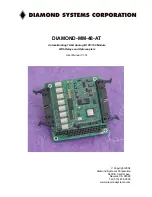
Configuring the IM4 as a Serial Module
12
IM4 Module Integration Guide
Configuring the IM4 as a Serial Module
In Serial mode, the IM4 interface provides two 16C850 UART channels,
an SPI channel, eight auxiliary inputs, and eight auxiliary outputs. It
appears as a serial port and you can use a communications program, such
as HyperTerminal, to communicate with it using the Basic Reader
Interface (BRI). For more information on the BRI, see the
Basic Reader
Interface (BRI) Programmer’s Reference Guide
(P/N 937-000-001).
All signals are 3.3 V logic levels (5 V tolerant inputs).
Low
High
Notes
Inputs
0 V to 0.8 V
2.4 V to 5.5 V
Input current is ±10 µA max
Outputs
0.4 V Max @ 8 mA
2.9 V min @ -8 mA
Note:
Pins with a # in the pin name indicate an active low signal.
Pins 7 (NC), 44 (IORD#), and 45 (IOWR#) determine if the IM4
operates in PC Card mode or in Serial mode. If the three signals are
grounded, the IM4 operates as a serial module.
These pins are carryovers from the PC card interface. These signals are
mutually exclusive for any PC card application. In order for the IM4 to
operate in Serial mode, you must ground all three of these signals. This
condition keeps the card from driving signals defined for serial operation
into a regular PC card socket.
Use these notes with the Serial Module Pinouts table on the next page.
1
You must use software to enable SPI channel. Until you enable this channel, inputs to it
are ignored and outputs to it are 3-stated.
2
The Debug signals are intended for use during any debug efforts. You can also configure
these signals for use as a second UART channel.
3
The Auxiliary outputs are 3-stated on power-up until they are written to the first time.
During this condition, you should provide pullups or pulldowns to keep any external
logic disabled.




































